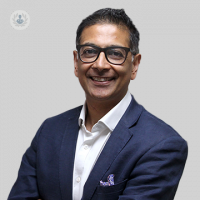EPSiT: a way to treat pilonidal sinus disease
Written in association with:A pilonidal sinus is a small tunnel that develops in the skin which can be susceptible to infection and abscess formation. These most frequently occur in the natal cleft, which is the crease between the buttocks. When such complications arise, there are several treatment options available, but choosing the best one can depend on several factors. For example, more recent minimally invasive techniques are now an option to treat infected pilonidal sinuses. Mr Tan Arulampalam, a leading surgeon, reviews the endoscopic pilonidal sinus treatment (EPSiT) option.

Key facts about pilonidal sinus disease:
- A common anorectal disease, with an estimated incidence of 26 per 100,000 people.
- More common in young men.
- Associated with being overweight and living a sedentary lifestyle.
- The main symptom usually presents as pain.
- It is common for infection to recur if not treated with surgery.
What treatment options are available?
There are several surgical options available, including:
- Open excision – these can result in large wounds which require frequent post-operative clinic visits for dressing changes, reducing quality of life.
- Flap-based excisions
- Minimally invasive techniques – e.g. EPSiT
There is also a choice in how the wound is left to heal following surgery:
- Leaving the wound open to heal – this generally achieves a lower recurrence rate, but requires weeks of wound care.
- To close the wound – this achieves faster healing rates, but risks a higher recurrence rate.
The type of treatment used should be based on the surgeon’s experience of each procedure and how successful they are in terms of healing speed and recurrence rate in line with each technique.
What is EPSiT?
Endoscopic pilonidal sinus treatment involves two steps:
- A diagnostic phase: this involves the insertion of a fistulascope into the opening of the pilonidal sinus to assess its anatomy;
- An operative phase: this involves the use of forceps for the removal of any hair and hair follicles within the tract. Next, a special electrode is used for the cautery ablation of the tract, ensuring that any necrotic material is removed. The resulting wound is dressed lightly.
How successful a treatment is EPSiT?
When comparing EPSiT to conventional open surgery, the following are the main criteria to take into account:
- Pain
- Time taken off work
- Complete healing
- Patient satisfaction
Pain:
EPSiT was found to have no or minimal pain than conventional surgical methods, which can easily be dealt with simple pain management therapies. This is likely due to the smaller incision made in the operation.
Time taken off work:
Patients who have EPSiT generally have to take less time off work, partly due to less pain being experienced with this technique.
Complete healing:
Patients having EPSiT will frequently achieve complete healing with a low level of recurrence in their pilonidal sinus.
Patient satisfaction:
Due to little pain experienced and reduced time taken off work, patients who have EPSiT frequently have a high satisfaction rate.
Hence, despite the need for specialist equipment and the longer operating time of EPSiT compared to conventional methods, the success of EPSiT is evident. In an ideal world, the best treatment for pilonidal sinus disease should be simple, painless, have high healing rates, low recurrence rates and involve minimal patient inconvenience. Hence, EPSiT is very promising so far in the treatment of pilonidal sinus disease.
If you are concerned that you may be suffering from pilonidal sinus disease, make an appointment now with an expert.


